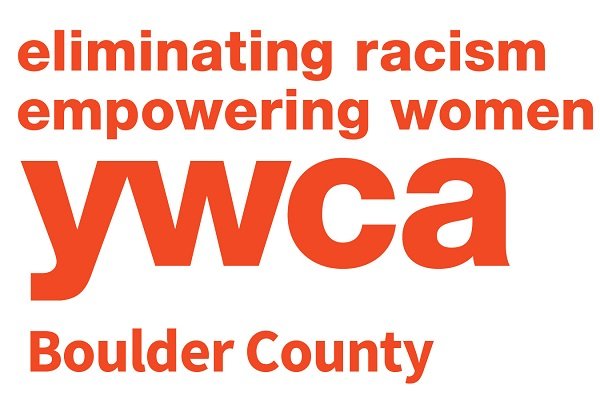YWCA Boulder County
Land Acknowledgment Statement ↘
Our mission to eliminate racism and empower women means that we work toward right relationships with Native Peoples.
Today we acknowledge the Boulder Valley’s history.
In 1859, gold seekers looked to the hills west of Boulder to find fortune in Arapaho and Cheyenne hunting grounds. Twelve years later, the City of Boulder was incorporated, in direct violation of the Fort Laramie Treaty the U.S. government had with the tribes native to this land.
YWCA Boulder County acknowledges that the land where we live today is the unceded territory of the Hinóno’éí (Arapaho), Tsistsistas (Cheyenne) and Nuciu (Ute) nations.
We honor Chief Left Hand (Niwot or Nawath), leader of the last Hinóno’éí band to spend their winters in the Boulder Valley. Many Hinóno’éí and Tsistsistas people were massacred by the US Cavalry at Sand Creek, Colorado, in 1864. The survivors were forced out of Colorado to reservations in Wyoming and Oklahoma, where most Hinóno’éí and Tsistsistas live today. The Nuciu were forced onto reservations in southwestern Colorado, New Mexico and Utah.
In our daily lives, let us remember that the Boulder Valley is home to the Hinóno’éí, Tsistsistas and Nuciu people and to many other tribes that also camped, hunted, and traded here for centuries. And that Native people of many Indigenous nations live here today.
Additional Context and Resources
What is a Land Acknowledgement?
A land acknowledgment statement recognizes that Native peoples are the original stewards of the land on which our homes and communities stand today. Land acknowledgements are a first step in educating ourselves about the events that led us to this place; understanding our shared and often painful history; addressing the continuing practices of colonialism and our participation in them; and honoring the special relationship that Native peoples have with this land.
Land Acknowledgement Resources:
Toward a Right Relationship with Native Peoples — Boulder Friends Meeting/Friends Peace Teams
Native Land Acknowledgements are not the same as land — Bloomberg News
Boulder and Sand Creek
Boulder County residents actively participated in the Sand Creek Massacre as members of the volunteer Third Colorado Regiment. On November 29, 1864, the regiment attacked a peaceful encampment of Cheyenne and Arapaho families near Sand Creek in southeastern Colorado. More than 200 Native people — mainly women, children, and the elderly — were killed by the regiment, whose acts of brutality were investigated by Congress in 1865. Among those killed was Chief Niwot, leader of the Hinóno’éí people who spent their winters in the Boulder Valley.
Fort Chambers, near present-day 63rd and Valmont, was one of the staging areas for the Third Colorado Regiment before they set off for Sand Creek. The site is now owned by City of Boulder Open Space and Mountain Parks. Activists with Right Relationship Boulder are currently advocating for the city to consult with the Cheyenne and Arapaho people about future use and interpretation of the site.
Vibrant Native Communities Today
Explore these resources to learn more about the Native communities with enduring ties to Boulder County:
Northern Arapaho Tribe of Wyoming
The Northern Arapaho Tribe is one of four groups of Arapaho who originally occupied the headwaters of the Arkansas and Platte Rivers. On September 18, 2021, the Northern Arapahoe Tribe and the City of Longmont signed a Sister Cities agreement. As part of the celebration, youth volunteers and staff from YWCA Boulder County’s STEM E3 program participated in a special tech fair for Longmont and Northern Arapaho students.
Cheyenne and Arapaho Tribes of Oklahoma
Tsistsistas and Hinóno’éí (Cheyenne and Arapaho) tribes function as one Nation while each maintaining their distinct culture, language, and traditions.
Southern Ute Tribe of Colorado
The Southern Ute Tribe, located south of Durango along the New Mexico border, recently opened a new cultural center and museum in Ignacio, Colorado.
Ute Mountain Ute Tribe of Colorado and New Mexico
The Ute Mountain Ute Tribe are the Weeminuche band of the Ute Nation of Indians. Their website features a video about their history and culture.
Ute Indian Tribe of Utah
The Uintah and Ouray reservation, located in northeastern Utah, is the second largest reservation in the United States and covers more than 4.5 million acres.
Indigenous Activism
Learn more about efforts to combat the enduring effects of colonialism, including here in Colorado, and how you can raise your voice for justice.
Womxn from the Mountain
Founded in 2018, this Denver-based group provides cultural programming to raise awareness of issues such as Missing and Murdered Indigenous Women (MMIW), domestic violence, mental health support and environmental awareness. The Denver Post recently profiled their efforts advocating for better tracking of Colorado’s missing and murdered Indigenous people at the state and local level.
Haseya Advocate Program
This Native woman-led organization, based in Colorado Springs, serves Indigenous survivors of domestic and sexual violence. Program Director Monycka Snowbird (Anishinaabe) recently wrote an article for History Colorado discussing the crisis of violence against Indigenous women. In some areas in the U.S., murder rates for American Indian and Alaska Native women are ten times the national average.
National Indigenous Women’s Resource Center
NIWRC is a Native-led nonprofit organization based in Montana that is dedicated to ending violence against Native women and children. Their efforts include advocating for the reauthorization of the Violence Against Women Act (VAWA), which is also a major legislative priority of YWCA USA.
Native American Rights Fund
For more than 50 years, this Native-led organization has fought for the civil rights of Indigenous people. Current efforts include protecting voting rights and access for Native Americans and addressing the devastating legacy of federal policies that forced Native children from their homes and into boarding schools.
